Modern homeowners increasingly prioritize sustainability when choosing flooring. Options like cork and bamboo offer durability and style while minimizing environmental impact. These materials grow quickly or come from renewable sources, making them practical choices for eco-conscious living spaces.
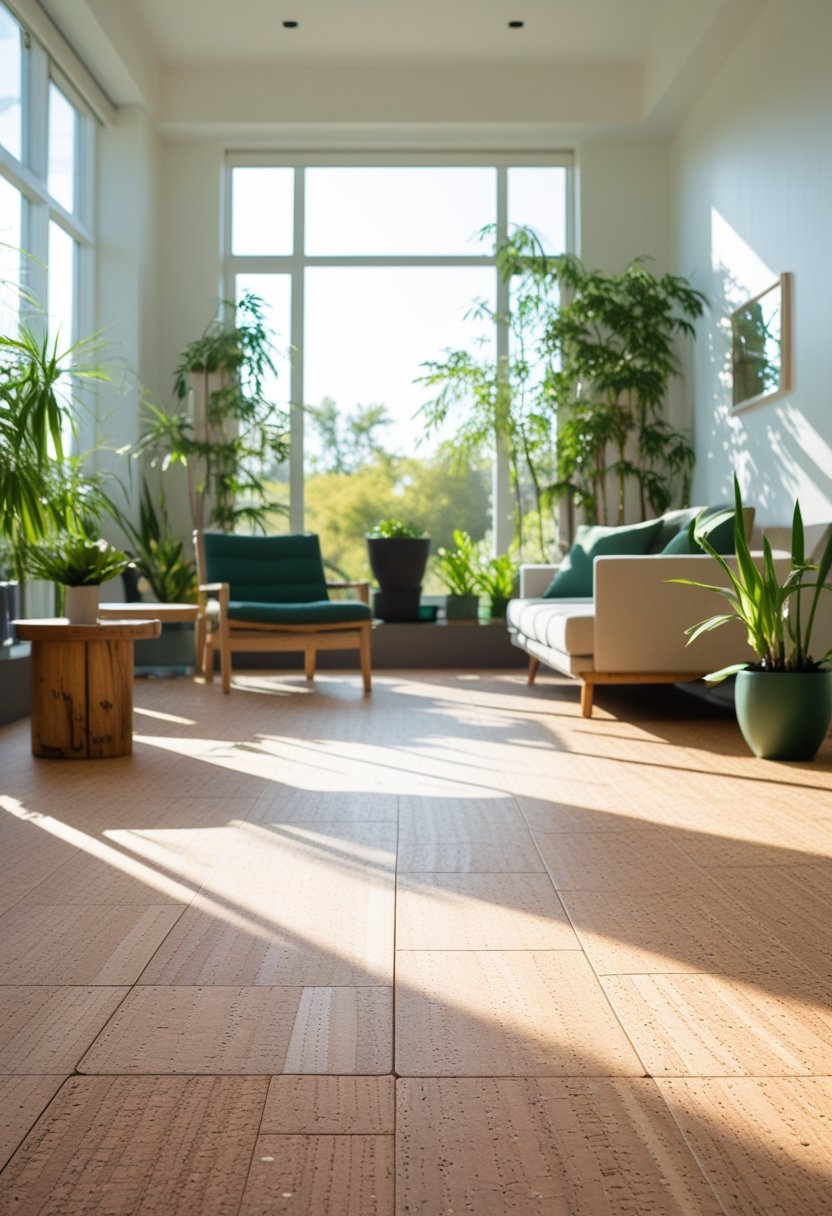
Eco-friendly flooring options such as cork and bamboo combine sustainability with natural beauty, providing healthy, long-lasting surfaces for contemporary homes. Beyond their eco benefits, these materials bring unique textures and qualities that suit a variety of interior designs, enhancing both comfort and aesthetics.
Understanding the benefits and characteristics of popular sustainable flooring helps homeowners make informed decisions. Whether it is the antimicrobial properties of cork or the rapid renewability of bamboo, these options represent a shift toward greener building practices without sacrificing performance.
What Makes Flooring Eco-Friendly?

Eco-friendly flooring focuses on materials and practices that reduce environmental impact while supporting healthier indoor environments. It involves using resources responsibly, promoting renewable options, and minimizing harmful emissions.
Defining Sustainable Flooring
Sustainable flooring is characterized by its minimal environmental footprint throughout its lifecycle. This includes sourcing raw materials responsibly, manufacturing with low energy use, and ensuring long product life or easy recyclability.
It often incorporates materials that regenerate quickly or come from managed forests. Sustainable flooring also avoids toxic chemicals and reduces waste in production and installation.
Choosing such flooring means prioritizing durability, renewability, and the ability to be repurposed or recycled rather than discarded.
Renewable and Recyclable Materials
Renewable materials like bamboo and cork grow rapidly and can be harvested without depleting natural resources. Bamboo, for example, can mature in 3–5 years, making it a highly renewable alternative to hardwood.
Recycled options, such as reclaimed wood or flooring made from post-consumer materials, help reduce landfill waste and lower demand for new raw materials.
Materials like linoleum also offer biodegradability, adding to environmental benefits. Responsible sourcing certifications, like FSC for wood products, ensure forests are managed sustainably.
Health and Indoor Air Quality Considerations
Eco-friendly flooring improves indoor air quality by minimizing the release of volatile organic compounds (VOCs). Many conventional flooring materials emit VOCs that can harm respiratory health.
Sustainable flooring options often use natural adhesives, finishes, and materials free from harmful chemicals. This reduces off-gassing and creates a healthier living space.
Selecting flooring with low or zero VOC certifications supports better air quality and limits exposure to allergens and irritants inside the home.
Bamboo Flooring: The Modern Green Choice
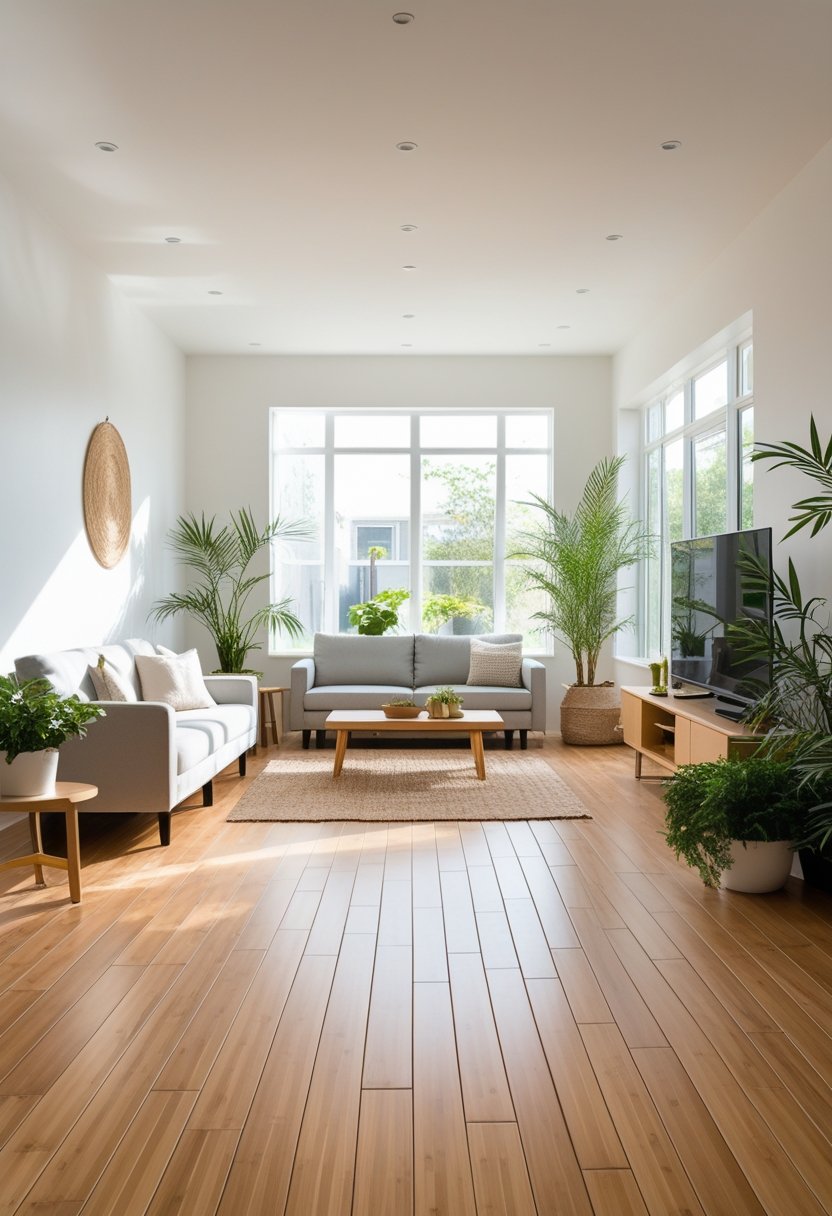
Bamboo flooring offers a durable, stylish alternative that meets modern sustainability standards. It combines rapid renewability with practical benefits like easy upkeep and recognized environmental certifications, making it a popular choice for eco-conscious homeowners and builders.
Environmental Benefits of Bamboo
Bamboo grows much faster than traditional hardwood trees, reaching maturity in 3-5 years compared to decades for many woods. This rapid growth allows for frequent harvesting without long-term deforestation.
Harvesting bamboo also supports soil stability and reduces erosion. It requires minimal pesticides and fertilizers, lowering chemical impact on the environment. Additionally, bamboo sequesters carbon efficiently during growth, helping to reduce greenhouse gases.
Its natural durability and hardness make bamboo flooring long-lasting, reducing the need for replacement. This contributes to less waste over time compared to softer flooring materials.
Installation and Maintenance Tips
Bamboo flooring can be installed using traditional nail-down, glue-down, or floating methods, offering flexibility for various subfloors and environments. Engineered bamboo is often recommended for areas with higher humidity due to its enhanced stability.
To maintain bamboo floors, regular sweeping or vacuuming prevents grit and dirt damage. Use a damp mop with a bamboo-specific cleaner or mild soap solution. Avoid excessive water to prevent swelling or warping.
Periodic refinishing is possible to restore the floor’s appearance, but the frequency depends on traffic and wear. Proper maintenance extends the floor’s lifespan and retains its natural aesthetic.
Certifications and Sourcing Standards
Look for bamboo flooring products certified by LEED or other reputable green building programs to ensure sustainable sourcing and low environmental impact.
Common certifications include FSC (Forest Stewardship Council) and FSC Controlled Wood, which verify responsible harvesting practices. Low VOC (volatile organic compound) certifications indicate safer indoor air quality.
Sourcing bamboo from well-managed plantations committed to sustainable practices is critical. It helps avoid products linked to deforestation or poor labor conditions, ensuring that bamboo flooring contributes positively to eco-friendly construction and design goals.
Cork Flooring: Comfort and Sustainability Combined

Cork flooring offers a unique mix of environmental responsibility and everyday comfort. It is sourced through a renewable process, has health advantages for sensitive households, and provides versatile options to fit modern interior designs.
Harvesting Process and Renewability
Cork is harvested from the bark of the cork oak tree without cutting the tree down. The bark naturally regenerates after harvesting, typically every 9 to 12 years. This process allows cork oak trees to live for decades, making cork flooring a highly renewable material.
Cork forests also support biodiversity and help with carbon sequestration. Harvesting promotes the health of these ecosystems, which benefits the environment beyond just the flooring industry.
This sustainable sourcing reduces deforestation and the need for synthetic materials. It contributes to cork flooring’s status as a leading eco-friendly flooring option.
Hypoallergenic and Health Advantages
Cork flooring is naturally resistant to moisture, mold, and mildew, which reduces allergens in a home. This makes it a good choice for people with asthma or allergy sensitivities.
The closed-cell structure of cork also absorbs particles like dust, improving indoor air quality. Additionally, cork’s softness provides a comfortable walking surface that reduces strain on joints.
Because cork is harvested without harmful chemicals, it generally avoids the off-gassing issues associated with some synthetic flooring materials. This supports healthier indoor environments in modern homes.
Style and Application in Modern Homes
Cork flooring comes in various types, including solid tiles, floating floors that click into place, and cork-backed hardwood or laminate options. This variety allows it to be used in kitchens, bathrooms, living rooms, and other spaces.
Its natural texture and warmth resemble hardwood while offering better sound insulation. Cork’s color range from light tan to dark brown can complement both minimalist and traditional interiors.
Durability and easy maintenance make cork flooring practical for family homes. It can also be combined with radiant heating systems for added comfort in cooler climates.
Beyond Bamboo and Cork: Other Eco-Friendly Flooring Materials
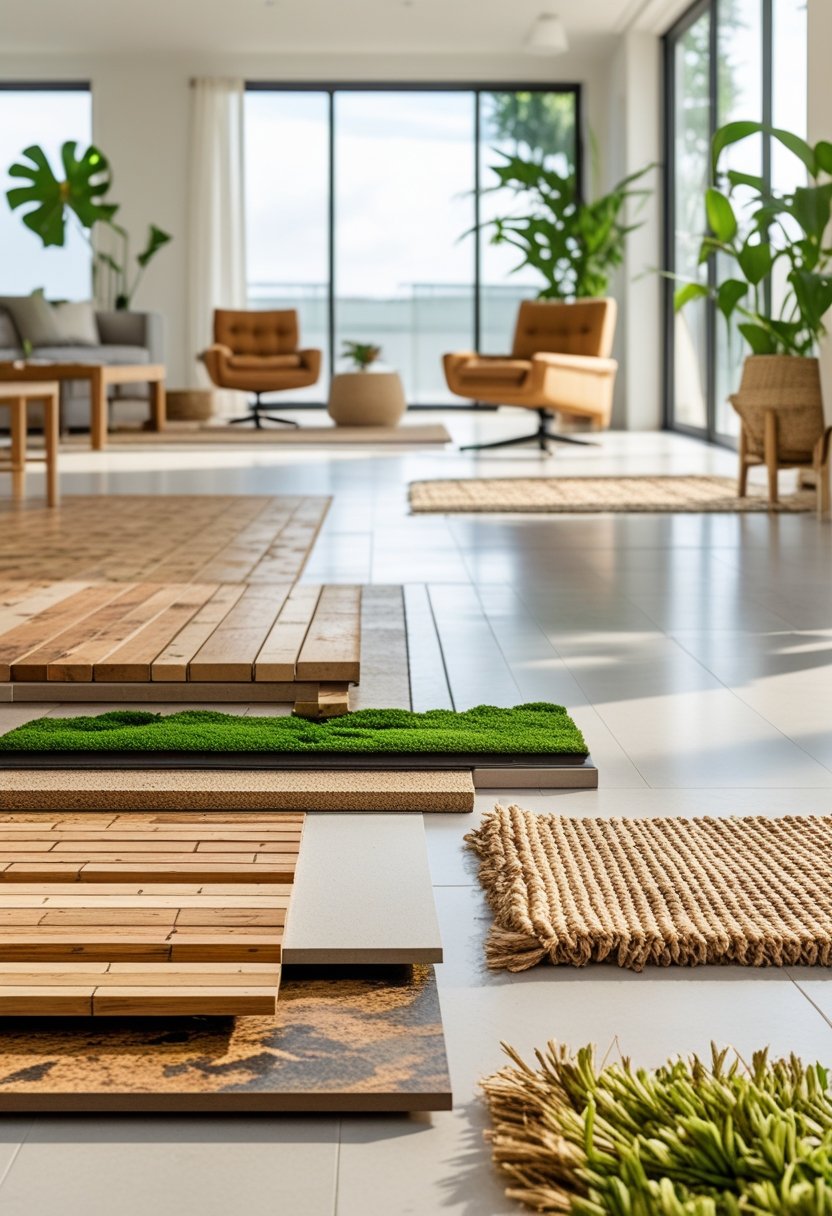
Several flooring materials offer sustainability alongside durability and design flexibility. These options bring unique benefits, from conserving natural resources to incorporating recycled content, meeting the needs of eco-conscious homeowners.
Reclaimed Wood for Character and Conservation
Reclaimed wood comes from repurposed old buildings, barns, or furniture, reducing the demand for new lumber. It preserves timber that has already matured, helping conserve forests and reduce deforestation.
This type of wood often features distinctive grain patterns and aging marks, adding character to interiors. It matches various design styles, from rustic to modern.
Beyond aesthetics, reclaimed wood is durable and can be refinished multiple times to extend its lifespan. It also requires less energy to produce compared to new hardwood, lowering overall environmental impact.
Natural Linoleum: Durability Meets Sustainability
Natural linoleum is made from renewable materials like linseed oil, wood flour, cork dust, and jute backing. It is biodegradable and does not release harmful chemicals, making it a healthy choice for indoor air quality.
Its durability is notable; linoleum can last for decades with proper care, resisting wear in high-traffic areas. It also offers a range of natural colors and patterns without synthetic dyes.
Maintenance is straightforward—regular sweeping and damp mopping keep it clean. Its resilience and low environmental cost make linoleum a practical option for eco-friendly flooring.
Wool Carpet: Renewable and Luxurious
Wool carpet comes from natural sheep fleece, a renewable resource replenished annually through shearing. It is biodegradable and often requires fewer chemical treatments than synthetic carpets.
Wool offers excellent insulation, improving energy efficiency by retaining warmth. Its natural properties also resist fire, moisture, and stains better than many synthetic fibers.
The texture provides comfort and luxury, making it ideal for indoor living spaces. Proper maintenance includes regular vacuuming and occasional professional cleaning to maintain appearance and functionality.
Terrazzo Flooring With Recycled Content
Terrazzo flooring combines chips of marble, glass, or other aggregates with a cement or resin binder. Modern terrazzo often incorporates recycled glass or stone, reducing waste and raw material use.
It creates a durable, low-maintenance surface that resists cracking and staining. Terrazzo is highly customizable, available in various colors and patterns, suitable for both residential and commercial spaces.
Its longevity means it rarely needs replacement, contributing to sustainable building practices. Installation requires skilled labor but offers a long-term eco-friendly flooring solution with aesthetic appeal.
Comparing Eco-Friendly Flooring Options
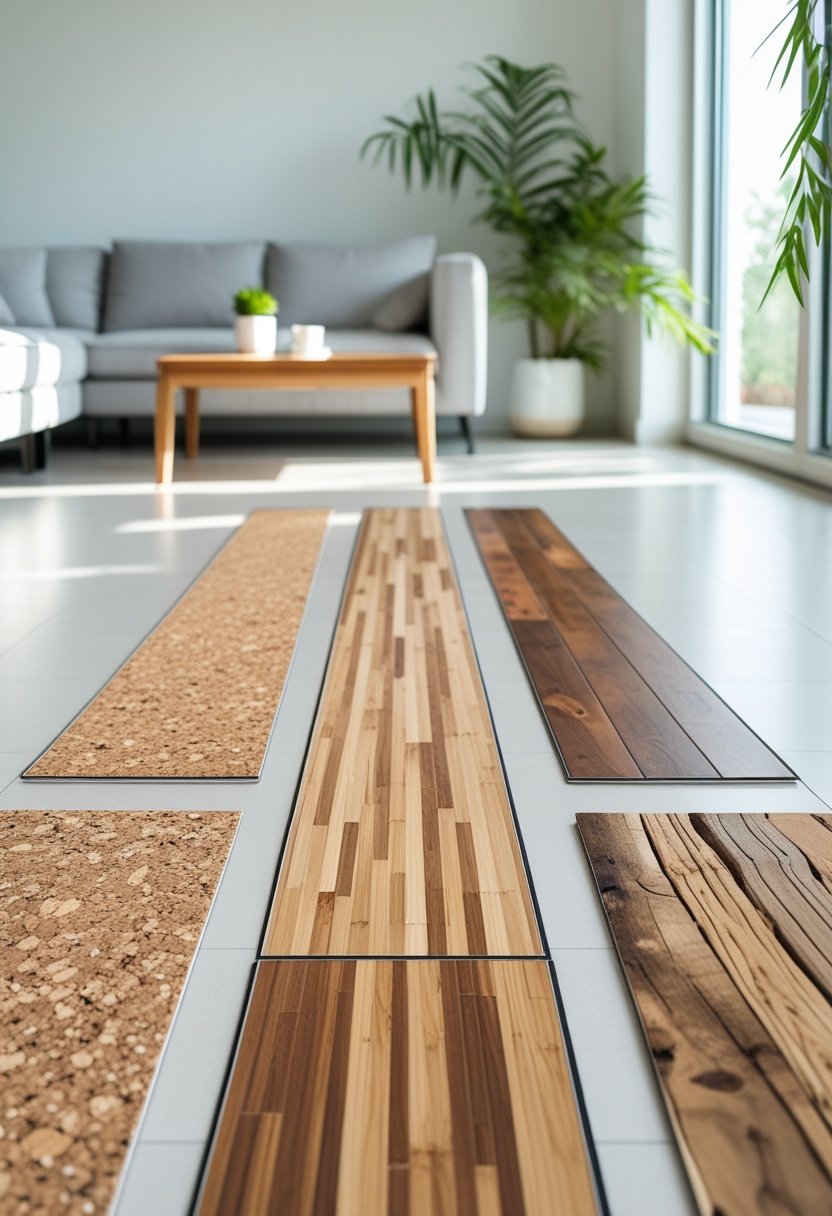
Eco-friendly flooring materials vary widely in their durability, cost, and maintenance needs. These factors are crucial for homeowners seeking long-lasting, affordable, and easy-to-care-for sustainable floors.
Durability and Lifespan
Bamboo is known for its high durability due to its dense structure, making it resistant to scratches and dents. It can last 20-25 years with proper care, especially strand-woven bamboo, which is harder than many hardwoods.
Cork offers moderate durability. It is softer and can compress under heavy furniture but recovers well. Cork typically lasts 10-15 years and is best in low to medium-traffic areas.
Reclaimed hardwoods provide excellent lifespan, often exceeding 30 years. They carry natural strength and age well but can be susceptible to moisture damage if not sealed properly.
Cost Considerations
Bamboo flooring generally costs between $3 and $8 per square foot, depending on quality and finish. It is affordable when compared to many traditional hardwoods.
Cork is priced similarly, ranging roughly from $4 to $7 per square foot. Installation costs may be slightly higher due to the need for specialized adhesives.
Reclaimed hardwood costs vary widely, often between $5 and $15 per square foot. The price depends on the source, wood type, and refinishing work required.
Maintenance Requirements
Bamboo requires regular sweeping and occasional damp mopping. Avoid excessive water, as it can cause swelling or warping.
Cork flooring benefits from sealing every few years to protect against moisture and wear. It is resilient but requires gentle cleaning to prevent damage.
Reclaimed hardwood demands periodic refinishing to maintain appearance and prevent surface damage. It should be cleaned with products suited for hardwood to preserve its finish.
Choosing the Right Eco-Friendly Floor for Your Modern Home
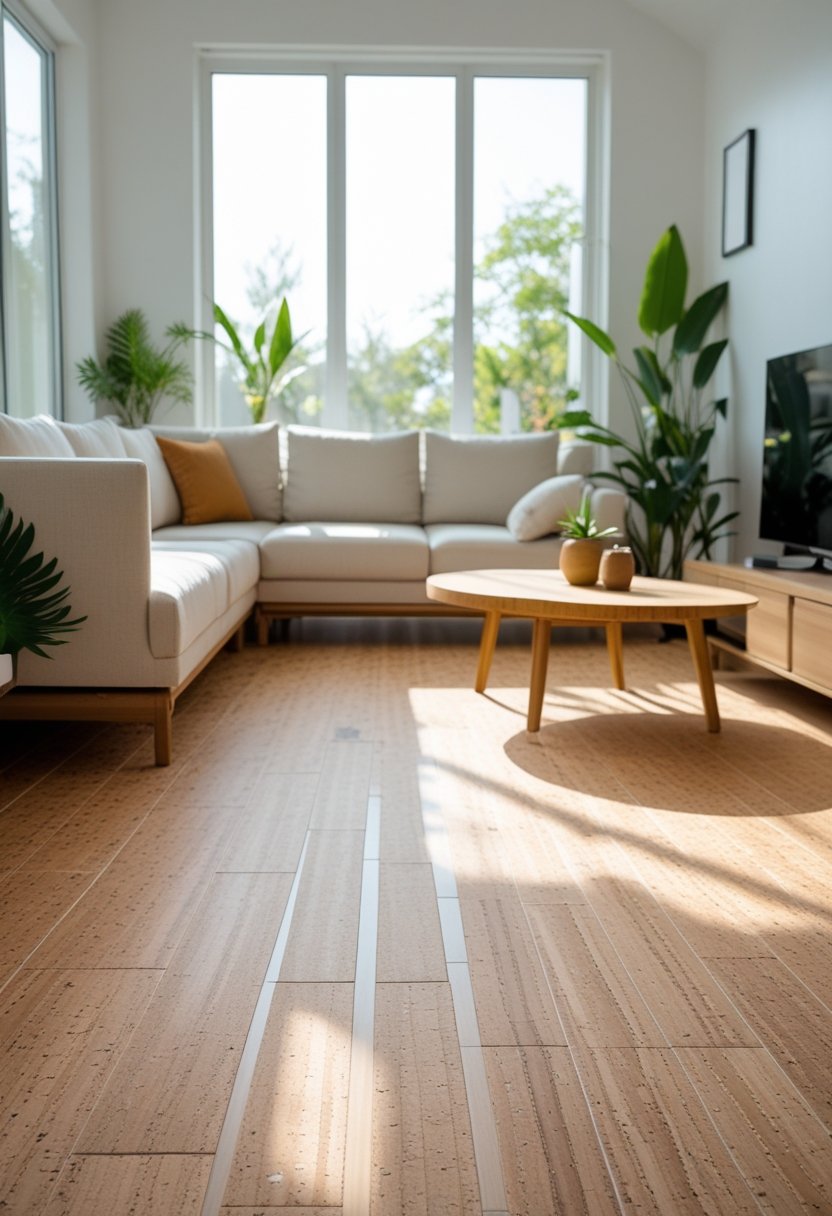
Selecting sustainable flooring involves evaluating how the floor will be used, ensuring it meets environmental standards, and matching it to the home’s design style. These factors help guarantee the flooring lasts, supports health, and fits the homeowner’s personal taste.
Assessing Lifestyle and Room Function
The choice of eco-friendly flooring depends heavily on a household’s daily activities and the intended room use. High-traffic areas like kitchens and hallways require durable materials such as bamboo or reclaimed hardwood, known for their strength and longevity.
Moisture-prone zones, like bathrooms, benefit from options such as cork or certain polished concrete finishes, which resist water damage. Families with children or pets might prioritize softer, hypoallergenic materials that are easy to clean and maintain.
Considering the floor’s expected wear ensures the selected material remains functional and eco-conscious over time without frequent replacement.
Certifications and Environmental Standards
Choosing flooring certified by organizations like LEED (Leadership in Energy and Environmental Design) guarantees lower environmental impact. Certified products often have sustainably sourced materials, reduced emissions, and responsible manufacturing processes.
Look for additional certifications such as FSC (Forest Stewardship Council) for wood products or FloorScore for indoor air quality. These certifications confirm that materials meet rigorous sustainability and health criteria.
Selecting certified flooring supports green building practices and contributes to healthier indoor environments by minimizing toxic chemicals.
Design and Aesthetic Preferences
Eco-friendly flooring options offer diverse styles, from the warm, natural look of bamboo to the unique texture of cork. Homeowners should consider color, texture, and how each material complements their interior design.
Modern flooring choices include polished concrete and reclaimed wood, which can add a contemporary or rustic touch depending on the finish. The aesthetic appeal must align with both personal taste and the overall design of the home.
Balancing sustainability with beauty ensures the flooring enhances the home visually while supporting environmental goals.

Ana Luisa
Explore in-depth biographies, net worth insights, and exclusive updates on your favorite singers at Trionua.com. Discover the journeys, achievements, and latest news about music’s biggest stars.






